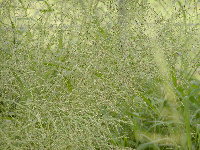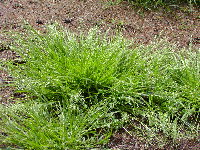FINCH GRASSES
.
By Doug Hill & Marcus Pollard
It has never ceased to amaze me how the simple topic of grasses for finches
can so often lead to such a heated debate! Views range from essential foodstuffs
to never, ever feed green grass to your birds - and every point of view in
between we might add!!
Often your geographic location has as much to do with your stance on feeding
grasses as anything. How so? Well, if you live in a dry, hot environment or a
dry, cool environment then chances are that you may look very favourably upon
the humble seeding grass head, whereas if you hail from a hotter, humid climate
then your blood may tend to boil when the question of feeding green grasses is
raised. How can this be so?
The main problem with feeding seeding grasses in hot, humid climates tends to be
the rapidity with which the grass becomes mouldy and potentially hazardous to
the finches that consume it. Mould and fungal spores thrive in these conditions
so it is imperative that you take steps to improve your husbandry when feeding
fresh grass. For example, feed it under cover so that it is free from rain and
NEVER allow the waste to build up on the ground below where your grass feeding
station is otherwise you will have real losses. Even in cooler climates we feed
our grass over a concrete floor so that a simple hand broom and pan will suffice
to sweep up after the grass is ripped to pieces. Remember too that most finches
spend a large part of their daily aviary fossicking on the ground and will be
only too happy to pick through this mass of discarded green material, ultimately
to their own detriment. Gravel and coarse river sands still allow seeds and
other grassy dregs to be hidden away to ferment nicely for the next tweezer-beaked
finch to decide to free load upon them – no such problems with a strip of
concrete, you can even vacuum clean it!
As most of the Australian finches are termed Grassfinches it would seem a
little remiss to design a diet for them that is devoid of fresh grass! So don’t
let anybodies bad experiences put you off, just sit back and design a way of
feeding your grasses so that the waste is not going to poison the birds you are
so desperately trying to breed.
What we are going to look at are some of the different types of seeding
grasses that are available out there for your finches and try to pick a range
that are decorative as well as good tasting!! As we come from differing ends of
the climatic scale (Hobart and Sydney!!) we hope we can pick a selection that
are freely available and able to be grown in most climes. We are aware that
everybody has their favourite grasses and we know that we will offend nearly
everybody by missing their ‘favourite’ but we hope you will give us your
indulgence, hey, you might even pick up a few new favourites!
Before getting straight into species we thought a little about presenting
grasses to your birds might help. Sounds pretty boring and straightforward doesn’t
it but we hope we can stimulate your brain cells just a little!
 |
Chuck
it in a heap on the floor: Bet you’ve all seen this in
action many times before! Make you shudder? It does us! Open the door
and toss it on the floor is the lazy finch keeper’s way and invites
disaster. Finches’ come down and trample all over it, use it for a
toilet, and pick it to pieces all day. If it is hot and humid as well
the lower layers build up heat and start to ferment and you are
reaching for the Nizoral when your finches come down with a fungal
disease or six! Add to this a dirt or sandy floor and your disease
potential is increased but that is nothing compared to the same grass
on a wet, damp floor. Here you have the potential environment for
protozoal (single celled organisms such as Cochlosoma, Giardia and
Coccidia) organisms and parasitic worms to abound, especially if the
"She’ll be right; I’ll pick it up tomorrow arvo if I
remember" attitude abounds!
|
 |
A
Pot plant on the floor: take a medium sized pot plant and insert
your grass into it! The grass stands upright and the birds pick up and
down the stems so more birds can feed – place half a brick in the
bottom of the pot plant and they’ll never tip it out. As they are
standing upright there is less chance for the grass to become soiled and
fermented – still no excuse not to get that pan and broom out though!!
If your pot plant is over concrete then you are looking much better. Pot
plant under cover and getting there! Still problems with seed on the
ground but, again, that is a husbandry matter and we tried to warn you!
|
 |
A
Bait holder on the wall: Take a small portion of plastic mesh and
fashion it into a small basket, seal one end and attach with screws to
the wall of your aviary. Keeps the grass off the floor and can be
attached so that there is no need to enter the flight too often. Again
better placed over concrete for cleaning purposes. A smaller pot plant
serves the same purpose but the plastic mesh is better!
|
 |
A
loop of wire suspended from the roof: This one is a great favourite
if you have Mannikins, Nuns or Munias. Simply suspend your loop of wire
at the desired height from the aviary roof and place a liberal hand full
of grass into it and twist the wire tight. Your birds will love climbing
up and down the entire stem of the grass, as they must do in the wild.
Again, easy to do and prevents the grass from sticking together. Some
smart people have invented a variation on this theme by suspending a
wire pot plant holder from the roof and placing the grass into it –
yep, try to have it over concrete if you are worried!
|
 |
The
rat trap on the wire trick: take a large rat trap and securely
attach it to the wire of your aviary and you now have a perfect clasp
for placing small bundles of grass (and nesting materials too) to your
finches – simply cock the rat trap, place your grass on the wooden
platform and CAREFULLY return the metal ‘back breaker’ to the ‘dead
rat’ position! Cheap and works for years sometimes, or at least until
the spring breaks!
|
 |
The
growing grass in the pot plant: In areas with modest rainfall, short
growing seasons and hot summers it can be difficult to keep up a regular
supply of grass for the breeding season. Simply select the species of
grass that you desire to propagate and transplant them into several
large pots and cultivate them as you would a favoured indoor plant. In
this manner you can pamper the grasses and ensure that they are green
and seedy when you need them most – the ground outside can be scorched
but your ‘secret stash’ is ready for action. If you plant enough
grasses you will be able to cycle them through your aviaries. Take a
nice green clump and put pot plant and all into the aviary and leave for
the desired period. Usually your nice, loved grass will be torn to
shreds before your eyes so that when you remove it from the aviary you
can simply cut it back to ground level, water it and watch as it readies
itself for the next onslaught! By cycling them in this manner you can
ensure that nest are not lost when Mother Nature freezes or withers the
grass outside – also handy when the council mows your favourite weed
patch! Just a tip for young players is to ensure that the drainage holes
in the pot plant are not large enough to harbour a mouse or three –
pretty sad when you have to admit after building all that expensive
rodent proofing that you actually put the mice into your aviary
yourself!! A rather sneaky way to prevent this is to have a 44-gallon
drum filled with water into which you sink your grass pot. After all, a
mouse can only hold its breath for so long! Allow to drain, remove soggy
meeces and place grass in aviary as per normal. As the root masses of
most grasses may provide safe harbour to any mice that might sneak into
your aviaries by having them growing in these pots you reduce this risk
considerably. |
|
Fig.1. Bait Boxes. |
Fig.2. As
A Grass Holder! |
Fig.3. Grass in Pots. |
Those a just a few methods for introducing green grasses into your aviary but
from Hobart to Cooktown the important thing is to prevent the fresh grass from
becoming a health hazard to your birds and, once again, this comes back to your
husbandry. So not only does the average fincho have to become an ornithologist
and an entomologist but also a horticulturist! So when you are checking your
feeding station list off and you note the seed, fresh clean water, crushed
cuttlefish, Canundra shells, crushed molasses salt lick, charcoal and soft food
mix DON’T forget your fresh seeding grasses!
THE SPECIES.
Ornamentals:
In this category there
are a number of grasses that are as much aesthetically pleasing as they are
nutritious. Perhaps the two that immediately leap to mind are the two tropical
species of Setaria, which are commonly seen in our aviaries.
Setaria palmifolia or Palm grass, as it is commonly
known, is originally from tropical Asia and has a large, broad ribbed leaf to
facilitate the run off of rainfall. It is not frost tolerant but will grow in
temperate area if protected. During spring and summer it produces long erect
seed ‘sticks’ which appear from the leaves in profusion. These are often not
eaten until they begin to turn brown and dry off but, from this point on, very
few seeds will be allowed to survive!! Napoleon weavers are very fond of these
seed and will eat them when they first appear.
Setaria sp. or Pit-pit grass as we in the ‘know’(?) call
it is very similar in habit to Palm grass but it has a finer, narrow leaf and
grows upwards more than outwards as Palm grass does. It can be trained into a
neat clump whereas Palm grass just seems to take over everywhere if left
unchecked. Both provide excellent nesting sites for birds that like the lower
regions to nest in. The seeds are as avidly eaten as for Palm grass.
Unfortunately both these species appear to be magnets for any mice in your
aviary so don’t allow either species to get out of control.
|
Fig.5. Palm grass Seed head. |
Fig.6. Palm grass Plant. |
|
Fig.7. Pit-pit grass Seed head. |
Fig.8. Pit-pit grass Plant. |
Pennisetum setaceum or African feathergrass as you may know it
is another excellent clumping grass for your aviary. As it has the tendency to
‘go mad’ even in Tasmania make sure that you ruthlessly prune it every
season. Weavers love to strip the green leaves to build from and Pictorellas
love to nest in it so how could you go wrong! The Pennisetum family has a
variety of different forms and seed heads vary from white through pink into
black depending upon the species. I must point out that if you are growing these
for show you may never actually get to see the seed heads as the finches favour
them for nest building. I don’t believe they actually wait for seeds to form
before destroying the seed heads!
If you are a Victorian then you may know this species as Zoo grass as, so I
am lead to believe, it was widely propagated from samples ‘collected’ from
the Gorilla cage at Melbourne Zoo!!
Among other great looking and bird friendly grasses are the Foxtails like Setaria
lutescens, the Miscanthus family with M.zebrinus (Zebra
grass) my favourite, the Calamagrotis or Reed grasses and, an Australian
native, good old Poa billardieri or Tussock grass. The Tussock grasses
are much loved by Weavers to strip for nesting and the Pictorellas and Chestnuts
will build their nest from the fine leaves as well.
|
Figs.9 & 10. African Feathergrass In Aviary
Situations. |
Cortaderia sp. or Pampas grass as it is universally known
is another invader that has a seed head much loved by many finches and is a very
common grass throughout Australia and a noxious weed to boot in most states!
Forget its ornamental properties unless your aviary is several meters high and
wide but focus your attention firmly upon the fluffy seed heads, which is often
2-3metres from the ground! We cut the seed heads down when they go ‘fluffy’
and store them upright in a container until they are fully dry then cut them up
with a pair of scissors and give to our birds. Ensure that the heads are really
dry before giving them to your birds as they will line their nests with them
and, if damp, then pneumonia is a real possibility.
|
Fig.11. Pampas grass Heads Drying. |
Edible Species:
Perhaps one of the best grasses for feed purposes is Guinea grass, Panicum
maximum, as most NSW and Queensland breeders swear by it for most of
their finches. In the wild we have seen Spice, Chestnut, Double Bar, Zebra and
Crimson finches feeding upon it. It is a tall, up to 2metre long grass with long
stems which contain a number of radiating seed heads. The seeds start green and,
upon ripening, turn a purple colour. Some breeders collect the seeds when ripe
and store them in the freezer for later use. In the Sydney area the grass is
normally ripe from the end of January until early April and is mainly found from
Nowra in the south of NSW right through to the top end of Queensland.
It grows well in well-watered areas and appears to be lusher and taller the more
water is available. Many breeders grow Guinea grass in pot-plants and cycle it
through their aviaries, thus giving it time to re-cooperate after the finches
have stripped it. We have grown it in cooler climes in pot-plants but it is a
sad, stunted affair compared to the Branxton variety!
This grass originated from Africa and it is probably no accident that a
friend in Gunnedah attributes part of his success with Orange-cheeked waxbills
to the availability of this grass. The grass is fairly drought tolerant and its
leaves are reputed to contain significant levels of protein. I have seen, to my
dismay and deep sorrow, vast areas of this grass growing in vacant lots and on
the edges of roads throughout NSW. A word of warning here should be to always
check with the local council before collecting grass to ensure that they haven’t
been sprayed with weed killer.
|
Fig.12. Guinea grass Heads. |
Fig.13. Guinea grass Plants. |
Barnyard grass or Watergrass, Echinochloa crus-galli, is
another important weed species that is a favourite of finches around the world.
This grass grows to around 1-1.5metres and is commonly found in well irrigated
areas and is a common ‘pest’ species in rice growing areas – proves the
old adage that one man’s pest is another man’s treasure, or did I muck that
up slightly!! Even in Tasmania we can occasionally pick small amounts from
irrigation ditches but there is usually a free for all to be first to it! We
usually pick this grass when it is beginning to dry off or, as Doug always
maintains, when the wild finches start to eat it. Some finches will ignore it
when presented green but the same birds will devour it and leave only stalks
when given half-ripe. This seed is well known for its tolerance to insecticides
and I well remember a talk with Col Pepper from Peppers Seeds at Quirindi about
this grass. We were standing in acres of the stuff and Col proceeded to tell us
how much he had spent on herbicides trying to kill it over the years, still
shaking his head he finished his story by telling us that he was now
deliberately growing the stuff!!! Fortunately for finch people everywhere
Barnyard grass is a key component of his Greens n’ Grains range! Just to show
you that finch keepers are a source of constant wonderment to their partners a
mate recently told me he had ‘located’ a plot of Barnyard grass in his area
and was relating his good fortune to his good lady
wife who, I believe, went off mumbling something about commitment and insanity,
or words to that effect!!! This grass is very similar in appearance to Japanese
millet – a component of all good finch seed mixes- but does not have the huge
seed head. It is a native of India and Europe.
|

|
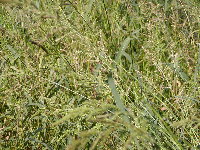
|
|
Fig.14. Barnyard grass Heads. |
Fig.15. Barnyard grass Plants. |
Don’t be too downhearted if you are from a temperate area of Australia as you
lust after all these tropical grasses as there are two species that are terrific
for cooler climes. Perennial veldt grass or Panic grass, Ehrharta
erecta, is just the trick for all finch keepers. Doug calls it God’s gift
to the finch breeder! It is highly drought tolerant and will re-emerge after
long dry periods with the smallest amount of rainfall. We grow this in pots and
cycle it through the aviaries, as it is highly resilient to ‘finch attack’
and recover rapidly for a second burst. We believe it was first introduced as a
lawn seed from southern Africa due to its drought resistant qualities. However,
its ability to do so has meant it has out stripped many preferred lawn grasses
and it is considered a weed in many areas. Easy to grow and transplant it puts
out many seed heads, mostly around 20cms high but, if conditions are good, it
may grow up to a metre in height but usually wrapped through other plant and
tree species. The seed heads can be fed at any time, unripe or ready to drop,
and the birds will leave nothing. What is not consumed will, invariably, be used
for nesting, as the stem is very pliable.
The other member of the Ehrharta family that is our salvation here in
Tasmania is what we call Veldt oats, E.longiflora. At first glance
you will see very few similarities between the two species as Veldt Oats appears
to be a miniature oats species and E.erecta appears more like a small
panicum plant. Veldt oats will grow anywhere given ample rainfall. It has a
purplish seed, which hangs in rows pointing downwards from the stem the seed
heads of both species are easily pulled from the plant which makes collecting a
breeze. Good rains in October ensure a vast amount of Veldt oats until around
January. Once the ground dries out the plants die but leave enough seed for
later seasons hidden away in the soil and we have known it to lie dormant for a
number of drought years only to reappear after three years absence! All birds
like this grass and many parrot breeders feed this to their charges. I have seen
it in a few places in Sydney but it does not appear to be to common further
north.
|
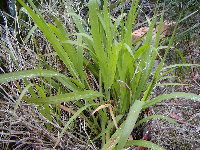
|
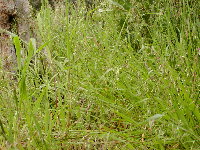
|
|
Fig.16. Veldt Oats plant. |
Fig.17. Veldt Oats Seed Heads. |
|
Fig.18. Panic Grass Heads. |
Fig.19. Panic Grass Plants in Pots. |
More assistance for the temperate finch keepers is at hand with the good old Wintergrass,
Poa annua. Commonly seen around paths and in lawns this small clumping
grass is usually only a few centimetres high but given wet, rich conditions it
can produce seed heads up to around 24cms. This species appears to be the bane
of turf keepers Australia wide but as a bird feed it has few equals. The whitish
seed heads are easily collected or you may like to simply use a spade to
relocate the entire plant into your aviary. If growing in irrigation ditches you
are often able to peel the grass up as the individual plants clump together into
a large mat. Even here in Tassy it is generally available 12 months of the year.
The Diamond sparrow appears to be particularly addicted to this grass.
|
Fig.20. Wintergrass Plants. |
Fig.20. Wintergrass Seed Heads. |
Rye-grass, Lolium perenne, if Perennial rye grass but we suspect
that there are a number of other Rye-grass species available in Australia.
Generally they are very similar in habit but their size is variable. Rye is one
of the fastest growing of all grasses and, generally, has a long seed head,
around 5-20cms, packed with seeds, which can be fed to your birds at any stage.
What isn’t consumed in the first few minutes will be carted off for nest
building, especially by the Diamond sparrow when green as it uses these stems to
build the outer shell of its nest!
This species is another favourite of the good old lawn seed mix and, if you
decide to keep finches to any degree, you might find your well manicured lawn
would be far more beneficial if you let it go to seed – oh, the domestic
upheaval!! For you will see the Rye grass heading up in no time flat so pick it
for your birds and THEN mow the lawn to restore domestic harmony!! The seeds
from this species are frequently seen in canary tonic mixes and they are about
the length of canary seeds but narrower and lighter. Mike Fidler, now a resident
of NSW, includes this in his seed mixes fed as a supplement to his breeding
finches. The seeds are amazingly resilient and I recently ‘found’ a bag that
was 25 years old and was stunned when it proved to still have a 100% germination
rate!! As this grass has a very stiff seed head it can be hung from the aviary
as mentioned earlier much to the delight of the Munias and Mannikins in your
finch collection. This grass is often found in parklands and just off the verges
of lawn areas.
|
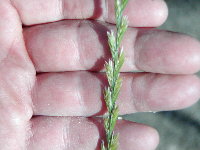
|

|
|
Fig.21. Rye Grass Seed Head. |
Fig.22. Rye Grass Plants. |
Wild Canary grass, Phalaris sp., is a group of grasses that are
cultivated for stock feed in most cases. Very common through temperate areas
they form large clumps with seed heads up to 1-2m in the air. The seed head
stalk is long and coarse and the actual seed head is similar to canary seed
heads except more elongate and longer, there are very few seeds per head. The
seeds themselves are the same shape as canary seed but a brown colour and, in
the species we use in Tasmania, slightly smaller. It is an easy matter to cut a
bundle of seed heads when they appear. There appears to be some debate as
whether the seed heads from this grass are poisonous when green. However, if fed
green, I have never had finches touch it and we usually wait until we see the
wild goldfinches feeding on it before we cut it for our finches. If fed when the
heads are beginning to turn brown all finches will tear it to pieces in search
of those elusive seeds and, as we’ve never suffered losses from feeding this
seed, we assume it is, obviously, non-poisonous when ripe! The entire Phalaris
plant can be used for your finches by simply using a brushcutter to cut the
grass off at ground level, gather up all the grass, leaves and seed heads and
simply dry it out and give it to your finches for nesting material. Again the
larger grassfinches love this for the outer husk of their nests, especially
Parrotfinches and Firetails.
|
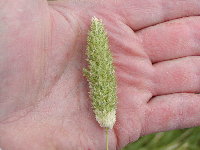
|
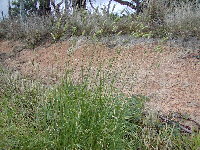
|
|
Fig.23. Phalaris Seed Head. |
Fig.24. Phalaris Plant. |
By now you are, no doubt, saying "But they haven’t even mentioned
Johnson grass, Newcastle grass or Umbrella grass let alone the huge panic
grasses we have in Queensland!! The very nerve of them, call themselves finchos!!"
Well, that’s probably very true so we’ll leave that up to other more
informed scribes as there are more grasses out there worthy of description. For
instance most finches would simply ignore Yorkshire fog or velvet grass, Holcus
lanatus, but the Beautiful firetail will strip this grass in preference to
most that we consider ‘far more attractive fare’! It will also not have
escaped the informed reader that most, if not all, of the grasses mentioned hail
from countries other than Australia but, then again, so do many of the finches
we hold in aviculture.
Be that as it may, we hope that we have provided a brief introduction to the
types of grasses available for inclusion in your aviaries. We would be remiss if
we did not include a word of warning here about collecting your grasses. As
mentioned previously, check with your local council about their spraying
operations in your area, try not to collect your grasses around poles and the
likes as these are much favoured by canines for toiletry purposes, when you have
collected your grasses ensure that you don’t just leave them in the bag but
instead spread them out to reduce ‘sweating’ which can lead to fungal
problems and always remove the left over grasses from your aviaries as part of
your daily cleaning regime. Oh, and another thing, watch out for any signs of
Ergot or Rust on the grasses that you are collecting as this fungus can be
detrimental to your birds. It appears as a reddish/purple dust on the seed heads
of many grain species – especially Rye grass unfortunately – and is easily
seen if you wipe your fingers over the seed head. It is a fungus of the Claviceps
genus and can cause convulsions and/or gangrene, depending upon the variety
present!
Haven’t scared you off collecting grasses yet then? Well, if you can’t be
bothered scouring the countryside with a copy of ‘What Grass is That ‘ or
some other weighty tome, then we suggest you prepare a patch of soil in your own
back yard and plant a portion of your best quality finch seed mix into it. For
aren’t all finch seeds members of the grass family themselves? This way you
can ensure that you have clean healthy seed heads for your finches when you need
them most. Who knows we might even see you down at the recycling shop searching
for even larger pot plants to transplant even more grasses for our finches.
Also remember that if you find a lush grass spot you can always collect more
than you need for immediate use and simply place the stems from the unused
portion in a bucket of water and they should keep fresh for a few more days –
with seed heads out of the bucket of course! - just remember to remove the
lower, wet section as they can go a little slimy in the bucket after a few days
– an ounce of prevention and all that……………But beware of where this
added form of finch addiction can take you for I well remember a good friend
taking me on a tour of his neighbourhood renowned vegetable patch only to see
slabs of Veldt oats, patches of Milk thistle, rows of Veldt panic and clump
after clump of Wintergrass. When asked about his veggies he simply stared at me
and shook his head saying "No room mate, I need my entire garden for the
finches now, I’m putting a row of red panicum over there where me tomatoes
used to be!" Did I spy his spouse reaching for the commitment papers??? Oh,
and did I mention that we haven’t even said a word about the multitude of
flowering plants (Dicots) out there for our birds? Finch keepers beware!!
|

|

|
|
Fig.25. Red Pannicum Seed. |
Fig.26. Corner Plot of Finch Mix. |
|
Fig.27. Finch Mix!! |
Fig.28. French White. |
Fig.29. Grasses Galore!! |
As Published in Australian Birdkeeper 2004












